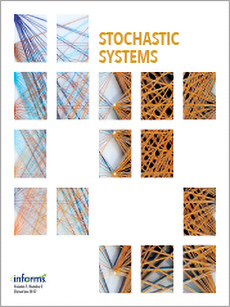Abstract
Envisaging a physical queue of humans, we model a long queue by a continuous-space model in which, when a customer moves forward, they stop a random distance behind the previous customer, but do not move at all if their distance behind the previous customer is below a threshold. The latter assumption leads to “waves” of motion in which only some random number $W$ of customers move. We prove that $\mathbb{P}(W>k)$ decreases as order $k^{-1/2}$; in other words, for large $k$ the $k$’th customer moves on average only once every order $k^{1/2}$ service times. A more refined analysis relies on a non-obvious asymptotic relation to the coalescing Brownian motion process; we give a careful outline of such an analysis without attending to all the technical details.
Citation
David Aldous. "Waves in a spatial queue." Stoch. Syst. 7 (1) 197 - 236, 2017. https://doi.org/10.1214/15-SSY208
Information





